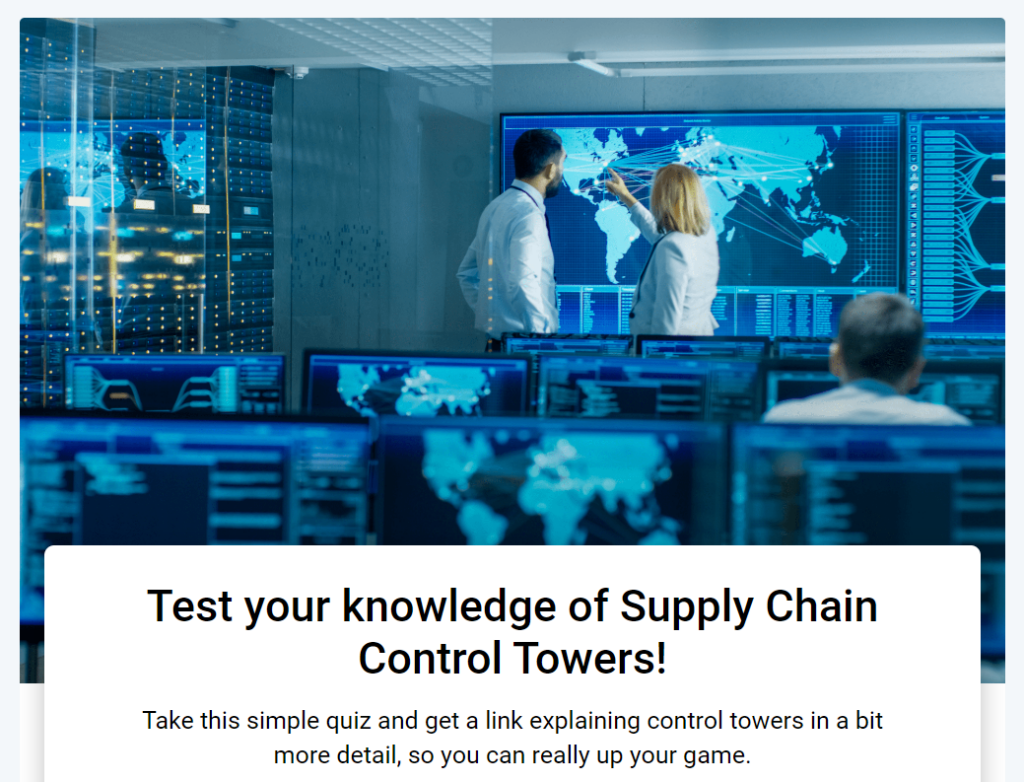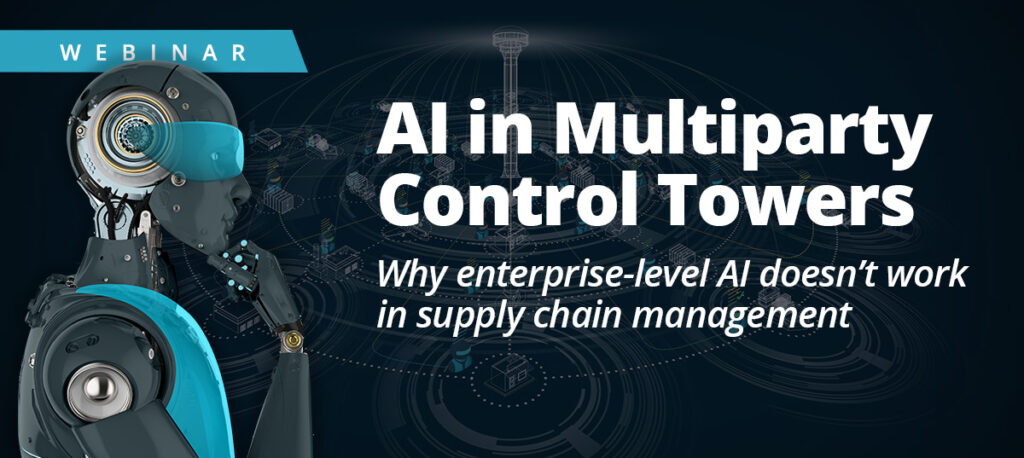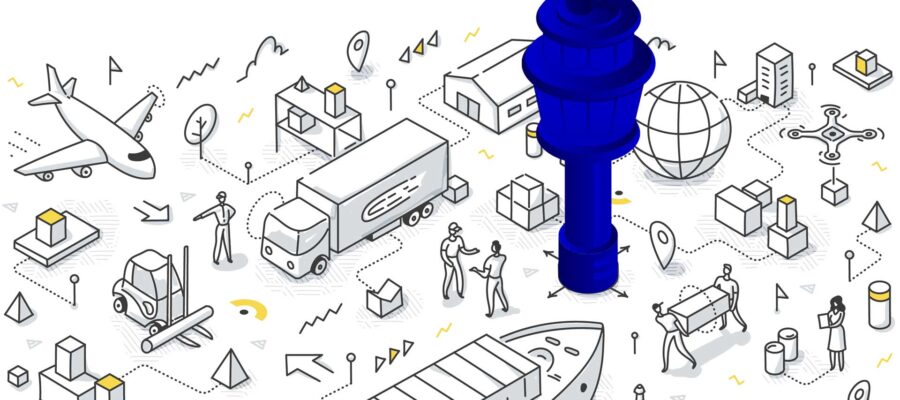This post has already been read 24031 times!
What each type of control tower can and can’t do
The term “control tower” has been grossly overused in the domain of supply chain management over the years and is used today to describe practically anything from basic visibility to network-wide fully autonomous solutions. This makes it nearly impossible for anyone looking for a capable solution to effectively compare options side by side.
In this post, I will break down the four main types of supply chain control towers, ranging from those that offer basic visibility and analytics, to those that let you act on exceptions in real time, and even go as far as autonomous execution.
What even is a supply chain control tower?
Supply chain control towers were initially envisaged as a command center or “war room,” a physical site that brought together analysts and data from various systems and trading partners. They were an attempt to assemble data and intelligence from across the supply chain via point solutions, data integrations, and swivel-chair processes.
4 Types of Supply Chain Control Towers – the strengths and weaknesses of control towers that supply chain practitioners need to know… Share on XAs a result, the supply chain operations team gained tremendous visibility, compared to earlier methods where teams operated in near isolation; and crucial information was collected to aid in decision-making and supply chain coordination.
The modern-day equivalent of a control tower is a fully integrated supply chain management system that provides end-to-end visibility, decision-making support, and fully autonomous execution capabilities. It enables all supply chain ecosystem participants to collaborate on the same set of data and provides views and actions on orders and shipments down to individual items.
Siloed vs. end-to-end control tower solutions
Before diving into the definitions of various control tower types, it is important to note that there are significant functional gaps among the control towers available in the market. Buyers should be aware that solutions differ in terms of whether their visibility and control span the entire supply chain or only focus on a specific function such as Transportation Management, Demand or Supply Planning, or Warehouse Management.
As explained in Nucleus Research’s report, Supply Chain Control Tower Value Matrix 2022: “with siloed Control Towers, planners and transportation analysts often find themselves bogged down with swivel chair operations that necessitate emails and last-minute meetings. This methodology proves too slow to adjust to large volumes of supply chain exceptions where planners lack confidence in their plans’ efficacy from a logistics perspective, and transportation users do not have visibility of their adjustments’ impact on inventory and capacity.”
Level 1: Visibility without actionability is not control
The fundamental premise of any control tower is that you have visibility into all the transactions, events, and milestones you want to track. Bringing together relevant data from all parties, facilities, inventory, and transportation into a single view provides visibility into all supply chain milestones and events. However, it is critical to understand and remember that some technology vendors refer to their analytics systems as control towers, even though they lack control. While these systems do compile and present copious amounts of data from various data sources and partners, users are unable to act on what they see. Although visibility and analytics are advantageous, a true control tower must eventually allow you to act on the data it provides.
Level 2: Actionability and collaboration
To be considered a true control tower it must, at a minimum, offer users both visibility and actionability. Beyond the basic ability to recognize and analyze events, it must also allow users to implement resolutions without disconnected systems like phones or email.
To successfully address difficulties that emerge throughout the execution process, several partners are frequently required, which is why a comprehensive set of collaboration and case management tools are often required.
Traditional supply chain and transportation management systems, while capable of seeing and resolving issues, frequently fall short of the capabilities of a network-enabled control tower. Ecosystem partners must be able to collaborate in real time on time-sensitive issues based on a single version of the truth.
Level 3: Decision support and scenario analysis
The ability to observe and act swiftly does not automatically result in the greatest resolution for your business. Expediting a shipment to avoid a projected out-of-stock is ineffective if the expedited products will not arrive before the next regular shipment.
With AI and machine learning becoming more integrated into various software systems, some control towers also provide users with decision support based on trends in historical data. This enables users to simulate scenarios before implementing a solution. However, if the algorithms are limited to operating entirely on stale data or making assumptions about, say, lead times, the recommended solution is unlikely to be particularly accurate.
Level 4: Autonomous and interactive execution
The most sophisticated control towers offer much more than simply basic visibility, actionability, and decision support. Powered by real-time network-wide data they natively support the complexities of tracking goods across global and often fragmented supply chains.
By fusing together both internal and external supply chain data they can calculate the propagation impact of any supply chain execution change. By utilizing prescriptive and predictive analytics they can solve complex issues and optimize entire supply networks.
Level 4 control towers use predictive and prescriptive analytics to autonomously solve complex issues and optimize entire supply networks. Read more: The 4 Types of Supply Chain Control Towers Share on XWhen a supply chain issue is detected, embedded AI algorithms leverage network-wide data to determine how to optimally resolve the issue and then carry out the resolution autonomously. Guard rails based on target KPIs enable the AI capability to automatically resolve problems at scale across the network. If the ideal resolution falls outside the user-defined guardrails, the user will be provided with a “smart prescription” and asked to execute the resolution. The control tower then measures and provides analytics on everything that has happened and learns from it.
The combination of both autonomous and interactive resolutions provides organizations access to the black-box nature of today’s AI/ML-based solutions. Dashboards offer an interactive decision-making capability through prescriptions as planners gain confidence in the decisions being made by the AI. Over time planners establish increasing levels of KPI-based autonomous decision-making, while routing AI-assisted prescriptions for decisions that require additional consideration to the workbench.
By automating the resolution of typical chores, at scale, organizations free up their professionals to concentrate on more strategic work. Networked control towers can be used by every trading partner in the supply chain providing complete visibility into the chain of custody for all parties and easy tracking of things like carbon emissions. They also facilitate mass serialization and lot tracking, to help organizations comply with global mandates such as U.S. Drug Supply Chain Security Act (DSCSA), and the Food Safety Modernization Act (FSMA).
“Connect Once” Control Towers
Companies with sprawling global supply chains, multiple tiers of suppliers, and a myriad of demand channels can benefit enormously from a control tower. But it is important to bear in mind, that not all “control towers” are actually control towers. And, if you want to take full advantage of the effectiveness and productivity gains from AI and ML, a network-based control tower that leverages all supply chain data, fused into a single, common data model, is a necessity.
This will enable your control tower to propagate the meaning of events to the various parties in the network. It will work with your existing systems, your external partners, and with the minimum IT effort while ensuring everyone is working from a real-time single version of the truth.
Additionally, every trading partner need only connect once to the network, then they can work with their suppliers, their customers, and any other partner on the network. This ease of implementation, and the fact that every partner can benefit from the system, is what drives the adoption of the control tower.
And let us face it, if no one else integrates into your system, it is not much of a control tower.
Test Your Control Tower Knowledge

Now is a good time to take the Supply Chain Control Tower Quiz and see how you do.
And if you’d like to learn more, I recommend watching AI in Multi-Party Supply Chain Control Towers to learn how modern control towers on a network are transforming supply chains.

Recommended Posts
- Are Micro Fulfillment Centers the Next Frontier in Retail Logistics?
- Rethinking Defense Supply Chains with Network-Based Command Centers
- How to Use Predictive Analytics to Streamline Cross-Border Logistics
- AI Plus Humans for Resilient Freight Forwarding in a Complex World
- Modern Defense Supply Chains: The Essential Capabilities for Multi-Domain Operations
- 3 Foundations for an Effective Multi-Enterprise Supply Chain Network - July 31, 2024
- What is a Digital Supply Chain Network? - June 25, 2024
- 4 Types of Supply Chain Control Towers - February 8, 2023
